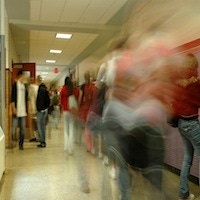Lights Out: Schools Under Threat From PCBs
Polychlorinated biphenyls (PCBs) aren’t good for humans. You probably guessed that by the name – they hardly sound like things you’d want to inhale or ingest.
 In fact, the Environmental Protection Agency (EPA) reports that PCBs cause cancer in animals and have a large number of toxic effects on humans including damage to the immune, nervous and endocrine systems along with reproductive issues.
In fact, the Environmental Protection Agency (EPA) reports that PCBs cause cancer in animals and have a large number of toxic effects on humans including damage to the immune, nervous and endocrine systems along with reproductive issues.
Most PCB-containing materials, such as fluorescent light ballasts (FLBs) and caulk, fell out of use in 1979 when the EPA phased out PCB processing. The problem? Older buildings, such as schools, still contain this hidden threat.
Of Bulbs and Windows
The EPA has released fact sheets on PCBs in schools, both those found in FLBs and hiding in caulk. Only tubular, “T12” diameter bulbs contain PCBs, but the EPA warns that even lamps that appear to be intact and not leaking may still pose risks.
This is partly due to life expectancy – magnetic FLB bulbs have a lifespan of just 10 to 15 years, meaning any still in use have been operating for more than three decades. In addition, some of these bulbs lack thermal protection (denoted on the lamp by a “P” symbol), meaning they’re at greater risk of overheating and generating PCB-laden smoke.
Caulk, meanwhile, may be present in many schools including in windows, door frames and masonry joints. Used to make small openings airtight or watertight, caulk once depended on PCB additives for flexibility. While airborne exposure is less likely than with FLBs, caulk is often more prevalent.
Going Up?
In Miami, Westport Middle School is facing a PCB crisis. While recent PCB samples were all within EPA limits of 300 nanograms per cubic meter – and only one room tested was over 100 N/m3 – in parts of the school, PCB concentration is rising.
Two rooms have already been closed and the school board has plans to abandon the facility as soon as a suitable replacement space is found for sixth, seventh and eighth graders. More worrisome than the risk of PCB exposure itself is the uncertainty: why are the levels rising?
To deal with this problem in existing facilities or schools where moving just isn’t an option, the EPA recommends frequent cleaning to reduce dust, the use of wet cloths or mops to lower the number of airborne particles and the use of high-efficiency HEPA vacuum cleaners, like those Goodway offers, to remove any existing contaminants.
Although PCBs have been off-limits for over 35 years, their legacy remains and continues to put schoolchildren at risk. Regular monitoring, thorough cleaning and eventual remediation are all critical in creating a safe learning environment.
Next Steps:
- Subscribe to our blog to receive the full blog series via email and stay informed about the latest HVAC news and insight.
- Stay up to date on facility maintenance tools such as chiller tube cleaners, boiler tube cleaners, hose/pipe cleaners, descaler systems, industrial vacuums, commercial pressure washers, and drain cleaners.

